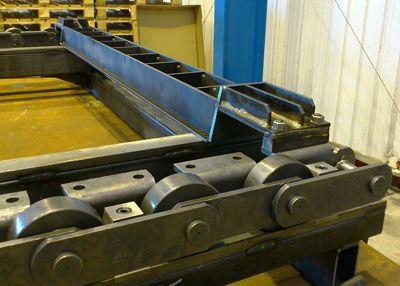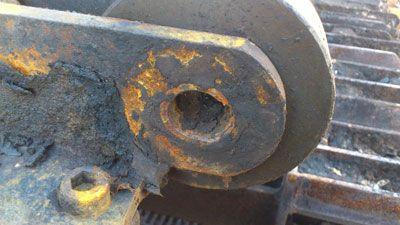Replacing the conveyor chain in fiberglass wool production significantly increases service life
- Details
- Hits: 5157
 A manufacturer of insulating glass fiber wool found out that premature wear of the chain installed in a conveyor system was responsible for the deteriorating product quality. He replaced the chain with a premium chain from the leading manufacturer of drive technology products, Tsubaki. This not only solved the quality problems, but also tripled the service life of the system.
A manufacturer of insulating glass fiber wool found out that premature wear of the chain installed in a conveyor system was responsible for the deteriorating product quality. He replaced the chain with a premium chain from the leading manufacturer of drive technology products, Tsubaki. This not only solved the quality problems, but also tripled the service life of the system.
Production maximization and cost reduction actually require that the plants are equipped with the best machine components and undergo regular maintenance. Unfortunately this is not always the case in practice as this success story shows.
Technology for fiberglass wool production
To make the fiberglass dam mats, molten glass is poured into a rapidly rotating perforated container. The ejected horizontal glass streams are converted by a downwardly directed puff of air or hot gas into fibers. These fall on a conveyor on which they combine with each other in a Velcro and sprayed with a binder. Two conveyors then compress the fiber mats to the desired thickness before being pushed into the oven to cure the binder.
Construction of the conveyor
 The conveyors are constructed so that a cross member is attached to each chain link on a large chain. These cross beams form a platform on which the glass fiber mat is transported. Just before the mat enters the oven, a second conveyor is added. They both squeeze the mat together and hold it in place as it passes through the oven. After the binder has cured, the mat has a uniform thickness and cools until it is ready for sale.
The conveyors are constructed so that a cross member is attached to each chain link on a large chain. These cross beams form a platform on which the glass fiber mat is transported. Just before the mat enters the oven, a second conveyor is added. They both squeeze the mat together and hold it in place as it passes through the oven. After the binder has cured, the mat has a uniform thickness and cools until it is ready for sale.
Short service life due to elongation and wear
The original conveyor chain lengthened very strong and had a high role wear, for which several factors were responsible: The chain lubrication proved due to the high operating temperature as suboptimal; the chain was difficult to access for the required maintenance and there was a risk of excessive lubrication which could contaminate the fiberglass mat. The elongation of the conveyor chain led to increased gaps between the cross members and impair the quality of the glass fiber mat as follows. While the glass fiber wool is compressed by the plates, the flatness of the surface is within a certain tolerance range. If the plates are too far apart and thus the distance between the plates is too large, the glass wool can be forced into the gap and form ridges. Thus, the flatness of the surface is disturbed at regular intervals by transverse beads. As a result, the chain only had a life of two years and then had to be replaced.
Application-specific solution
The drive specialist reviewed the application and investigated the causes for the early wear of the conveyor chain. Mainly the inadequate chain lubrication was responsible. The high furnace temperatures and the proximity of the chain to the finished product did the rest. The drive specialists then tuned the chain to the application and equipped it with some special features: Hardened, chrome-plated bolts and a molybdenum disulfide (MoS2) Lubricant, which ensures a high lubricity beyond the temperatures present in the oven addition. This dry lubricant also does not pose a risk of contamination of the glass fiber mat during the manufacturing process.
As a supplement to the conveyor chain, Tsubaki supplied suitable sprockets with inductively hardened teeth. By using the highest quality materials and the special hardening technology, the wear in the sprocket system is reduced to a minimum.
Installation and result in numbers
Engineers of the drive specialist installed the new conveyor chain together with the fiberglass wool manufacturer. They put special emphasis on the best possible alignment of the chain, which directly affects their life. Since then, the chain has run smoothly for more than six years in the truest sense of the word. She keeps three times longer than her predecessor.
Overall, the cost savings with a six-year term for the customer are significant: For the replacement of the conveyor chain, the machine had to be taken out of service for three weeks. In the past, annual maintenance costs amounted to 170.000 EUR, including the cost of production loss. The new chain can only be exchanged with this user every six years. This reduces the annual maintenance costs to a maximum of 62.000 EUR.
Over a period of six years, the customer could not only save about 650.000 EUR, but also gain six weeks of production time. In addition, the chain provides a consistent product quality.
